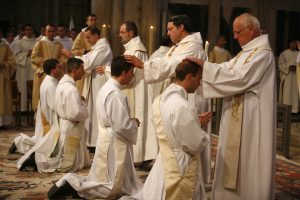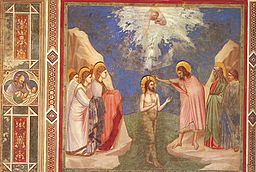2 Overview: Tools for Understanding Religion
Religious thought and action: Seven Dimensions of Religion
Religions appear to be only about ideas and beliefs. Much of the time, however, religion is doing, not just thinking. Religions engage body and mind in a total effort. One of the analytic tools that we use to see how this dynamic works is the Seven Dimensions of Religion suggested by Ninian Smart. The seven dimensions include narrative, ritual, doctrine, ethics, social organization, experience, and material culture.The seven dimensions help you see how religions operate as an active cultural system that engages body and mind.
Defining and Describing Religion: Cosmos, Humanity, and Transformation
The other analytic tool that we use helps us understand how each religion is a complete system within itself. We understand this system by examining how each religion understands the world; the problems faced by humanity; and the goals of transformation of each religion. Cosmology means the study of the cosmos or the universe. In religion, cosmology includes the idea of ultimate reality as well as ideas of creation. Some religions are theistic: they are focused on a supernatural being or beings that create and maintain the world. Other religions are non-theistic: they express the idea of ultimate reality as a natural law or the way of things. Buddhism, Confucianism, and Daoism are included in this category. Learn to recognize the expression of ultimate reality in its different forms.
Anthropology is the study of human culture. In religion, this means to understand how humans perceive their own life in regard to the ultimate truths taught by the religion. The anthropology of a religion often includes explanations of how human beings fail to understand ultimate value, whether this is embodied in God or as a principle of the universe. Why do humans fail to revere God? Why do we suffer? What is true submission to God? What causes sin? These questions are all about the relationship between humanity and why we fall short of ultimate truths. The anthropology of a religion also explains the role of humanity in the universe. In many religions, following the commandments and teachings of a religion are seen as supporting the order of the universe.
Soteriology means the study of salvation. This word has historically been associated with Christian theology, but in this course we are using it to describe how each religion provides a solution to the problem of human life. Each religion defines the problem of human life in a particular way. It then provides a solution to that problem, a method of human transformation. The method of transformation is what we define as the soteriology of each religion. In this course you will learn to identify how each religion understands reality (cosmology), the problem of human life (anthropology) and the solution to that problem (soteriology).
Analytic Tool #1: the Seven Dimensions
Ninian Smart developed the Seven Dimensions of Religion as a tool to understand the dynamic between different aspects of religion. Each of the seven dimensions interact with the other dimensions to create a total world of meaning that holds together. The following discussion of the seven dimensions is based on Smart’s description in his book, Religion and Human Experience.
Ritual
Smart explains that religion expresses itself through the actions of ritual such as prayer, worship, meditation, pilgrimage. Rituals often re-enact narrative events in the religion. The outer, physical form of ritual action is often prescribed by tradition or by doctrine. You have to be taught ritual since it is social and determined by the religious group. The physical actions of a ritual may deepen your understanding. For example, closing your eyes during prayer helps you concentrate. Ritual and narrative are often closely linked since the story of a religion may be enacted through ritual. For example, a children’s Christmas play deepens their understanding of the birth of Jesus and the meaning of Christmas by enacting the story.

Narrative or myth
Religious myths are narratives that provide the foundation for ritual, doctrine, belief and practices. Narratives are the cultural inheritance of religions because these stories are re-enacted through ritual, are explained through doctrine, and are passed down from one generation to another.
Many religious narratives describe supernatural events. For example, the narrative of creation in the Hebrew Bible describes events that no human could have observed. It is therefore not “history,” but includes a wider definition of what is true. The function of narratives in religion is to stimulate the imagination and give deeper meaning to what it means to be human.
Do not make the mistake of thinking that a “myth” is automatically false. Myths are stories that point to deeper psychological and social truths of a culture. These narratives provide a broad support for teachings or doctrines and ritual. The meaning of a foundational story is always greater than just the historical facts. This is because myth and narrative are continually interpreted by the believers themselves.

Doctrine
Doctrines are the teachings and explanations of a religion such as the relationship between God and other divine beings and humanity. Narrative is essential to doctrine because it provides the “why” for these teachings. For example, why should a Buddhist practice meditation? Because the narrative of the life of the Buddha shows how meditation can lead to an understanding of the cause of suffering. Dctrine explains how meditation helps a person attain the wisdom of the Buddha. Doctrines include ideas about creation and reality, divinity and humanity, salvation, and other beliefs found in religion. It is what many people think of as the core of religions. Doctrine often explains why rituals should be done, but rituals often produce new insights into doctrines.
Ethics
Ethical teachings are rules about how humans should live, advising humans about behavior that leads to ultimate value. Religious traditions usually have a code of ethics, including rules for behavior and ways to live a moral life. Ethical instructions are closely linked to myth, doctrine, and ritual by bringing the social and intellectual elements of these three dimensions into the personal life and behavior of the individual. For that reason, sets of rules like the ten commandments include both ethical guidelines as well as cultural taboos and rituals. This does not mean that every person who is a member of a religious institution follows these rules. The rules themselves are not descriptive of what humans actually do. Rather, they describe a norm for the human ideal.

Social Organization
Religious institutions have an organizational structure that implements the doctrines, ethics, and ritual life of the religious community. People who are trained in knowledge of the doctrines, ethics, and rituals of a religion are called religious specialists and often take positions of leadership and to transmit religious teachings from one generation to another.
Other members of the organization, sometimes called “lay” people, receive the benefits of these specialists and support them. Religious organizations interact with the surrounding culture in various ways. For example, in many societies, religious organizations have tax exempt status. Buildings, outreach groups, and charity work are all part of the organizational aspect of religion.
Experience
We sometimes think of religious experience as unusual, “altered” states of mind. The experience of religion, however, can be quite an ordinary thing that is part of one’s daily life. Sometimes these experiences occur in formal ritual settings, but they may also occur at home or at the office. We cannot see another person’s experience, but people communicate their experiences through language.
Religious doctrines, myth and narrative build up an idea of what a spiritual or religious experience must be. Social organizations and religious specialists encourage members of the religion to achieve states of mind and behaviors promoted by the religion. This cultural framework shapes how people perceive the world. For example, if you believe that God created the earth and all its creatures, that influences how you understand the natural world. From this point of view, religious experience can be quite an ordinary thing, deeply embedded in your attitudes.
Material Culture
We often think of religion as a set of thoughts or rules or ideals, but material objects are indispensable to religious life. For example, ritual implements are used in ceremonies. Ethical and doctrinal teachings are spread through books and manuscripts. In premodern societies where few people could read, illustrated manuscripts could help to spread the narrative of the religion.
For example, in Asia monuments called stupa became centers for worship and education about the religion through the sculptures and friezes on the walls of the stupa. Buildings also provide a sacred space for religious worship and a support for the social organization of the religion.
Material objects provide an opportunity for expressing religious ideas and a focus for devotional practice. In many cultures, people support religious specialists such as priests and monks or nuns by providing monasteries and facilities for spreading the teaching. All of these material objects are indispensible to religious life as a support and as an embodiment of the teachings of the religion.

Analytic Tool #2: Defining Religion through Cosmology, Anthropology and Soteriology
Let us return to the problem of defining religion. For this course, we will use a simple definition developed by William A. Young:
“Religion is human transformation in response to perceived ultimacy.”
Young explains that this is a working definition, or stipulative definition. By “working” or “stipulative” definition he means a definition that we will accept for the purposes of this present study. This is not the same as a lexical definition or dictionary definition of religion. Lexical definitions simply tell you how people have defined religion in the past. A stipulative definition recognizes that there may be many points of view about defining religion, but for the present purpose we are saying that this is the definition we will use.
If you look at this simple definition of religion, you can see the three categories of cosmology, anthropology and soteriology that are discussed earlier in this chapter. “Perceived ultimacy” is cosmology – what we think ultimate reality is. “Human” is anthropology – the study of humans. “Transformation” is soteriology: the goal of any religious system to transform human life. Young defines each of the three terms in his definition: human, transformation and ultimacy. Let’s take a look at each of these terms below.
Human
Young points out that religion is a human phenomenon. It involves both individuals and interactions within groups. Religion involves human activity in response to some perceived ultimate truth such as God or nirvana, or Brahman. When we study religion we study what we can observe: humans acting and explaining the world in certain ways.
This means that the study of religion tells us something about what it means to be a human. In this book, you will see many definitions of what it means to be human. Each chapter has a section labeled “anthropology” that tells you how the religion understands human life. When applied to religions, Anthropology means the study of how the religion views humans.
Transformation
Young’s definition of religion makes it clear that religion is a dynamic thing that can include many different kinds of human activity or thought. In order for an activity or idea to be counted as religion, however, it must be connected to a goal of transformation or change to a new state. This is the soteriology of a religion: a plan for how to realize the ultimate value of the religion.
Religions focus on questions concerning the problem or difficulty of human life. They may describe this problem in different ways, but they all identify a state of being which needs to be changed. This is the starting point of transformation. It answers the question, “What is the problem of human life?”
The question “what is the problem of human life?” suggests that there is an ideal state which humans should try to achieve. Religious doctrines and ethical rules attempt to answer the question, “What should we be?”
When religions define the problem of life and establish a goal, the next question is “How do we transform ourselves?” The means of transformation vary a great deal between different religions. Some religions such as Christianity focus on orthodoxy which means to have the correct beliefs. Other religions such as Judaism and Islam focus on orthopraxy which means to do the right practices, to live in a particular way. In this book, methods of transformation are described in the sections labeled “soteriology.”
Ultimacy
Religious phenomena are firmly linked to what an individual or group of people perceives to be the highest value, the supreme or ultimate. Young points out that ultimacy in religions refer to a higher plane or to spiritual beings beyond the natural world. In other words, although many people value money or material things, these would not qualify as ultimacy in religions.
Religions express the idea of ultimacy in various ways. For example, in the theistic Abrahamic religions of Judaism, Christianity, and Islam, God is perceived as a personal deity that transcends the natural world. In Buddhism, the state of nirvana is perceived as ultimacy. In this book, sections labeled “cosmology” describe aspects of ultimacy. In order to understand the perceived ultimacy of each religion you must look at many different aspects of the religion and see how it works as a total system.
Additional Terms for the Study of Religion
Sacred and Profane
Sacred and profane are considered by some theorists to be completely separate, but there are also religions that bring these two spheres together. The basic definition of these two terms are:
- sacred: things set apart from ordinary life that are regarded as ultimately valuable or real. This can include sacred time, space, beings, geography, animals, and objects. Purification rituals such as cleansing, restricted diet and actions are required for people to approach sacred areas or objects.
- profane: the actions, places, and objects of ordinary life. Profane does NOT mean evil.
Ritual Practices
Ritual practices are actions within a specific time and place that are organized by members of a religious group and may include special scriptures, language, and chants. Some of these actions include:
- offerings: to offer material objects to supernatural beings or to a sacred place in order to express connection, to ask for benefits, or to maintain the sacred.
- prayer: to communicate with sacred beings through language and mental focus.
- worship: acts of reverence toward a god, spirit, supernatural being,
- meditation: depending on the religion, meditation can include thinking about religious teachings or focusing the mind and body on a particular object to develop concentration.
- pilgrimage: to travel to places considered to be sacred and perform rituals there.
- asceticism: to practice self-denial in order to purify the mind and body and to gain knowledge of the sacred.
Cosmology
Cosmology is the general structure of the universe as described in religions. This includes the natural world as well as supernatural or sacred lands. Some useful terms when discussing cosmology are:
- transcendant: going beyond, achieving a higher state
- immanent: inherent, within this moment of time and space.
- revelation / revealed scriptures: to receive higher knowledge from supernatural sources. Scriptures in Christianity, Islam, and Hinduism are often considered to be “revealed” to humans by angels, spirits, gods or a God.
- ontology: ideas of existence and being.
- supernatural: beyond the natural world and the five senses. This can include gods, and spirits that are evil or good.
- pantheon: the hierarchy and relationships of gods and goddesses of a particular religion.
Types of Groups in Religion
Some terms refer to how religious groups are related to each other. Some common examples are:
- sect: a small group within a larger religious movement or organization.
- cult: a group that has separated from a larger religious group and establishes a separate culture and practice.
Syncretism
Syncretism Syncretism occurs when two or more religious cultures interact. There are various ways in which religions may combine. Syncretism can be seen as a process in which one religion influences another, for example, the adoption of Asian meditation practices by Christian congregations. In this example a single element, meditation, is brought into a religion without any doctrinal or ritual elements. A different process occurs when two religious systems combine to produce a religious culture that is different from either of the two original religions. An example of this second type of syncretism is the interaction between Shinto and Buddhism in Japan. Although both of these religions retain their independence from each other as religious systems, their combination developed forms of religious expression that are unique to Japan. The best way to see how this works is to study specific cases of syncretism. Seeing the World through Religion and Culture provides two chapters that discuss different aspects of syncretism:
- Religions of Japan.
- Native American Religion.
These two chapters show how syncretism reflects the essential flexibility and creative of religious traditions which are living examples of cultural change.
